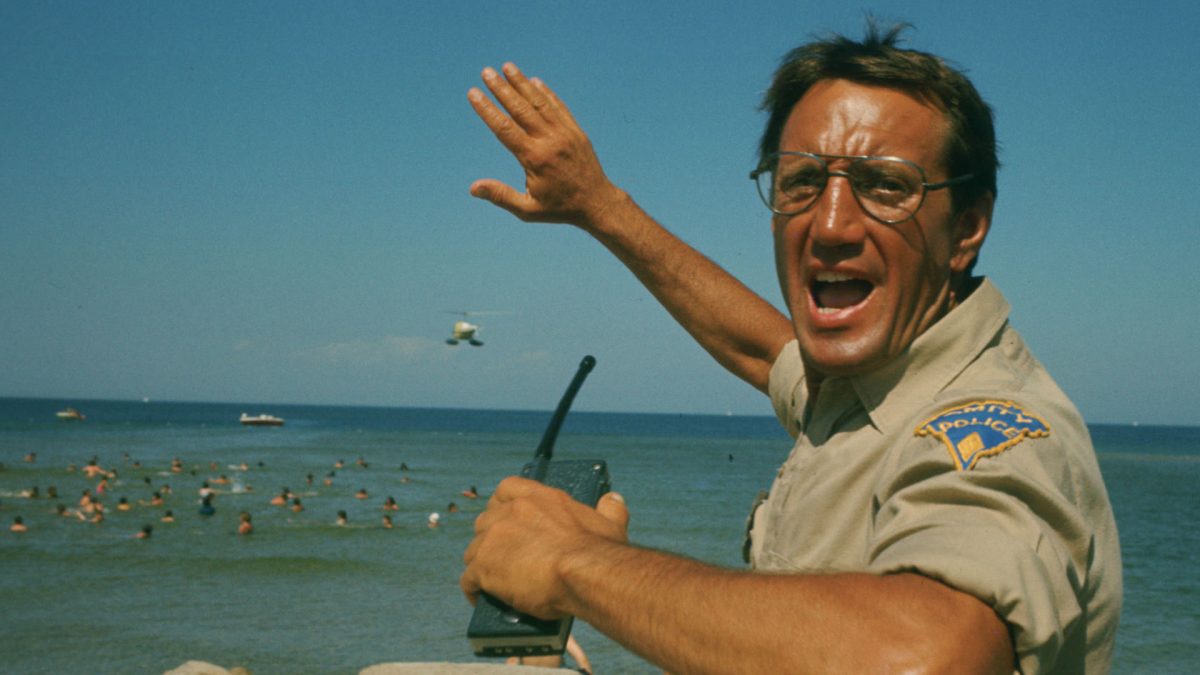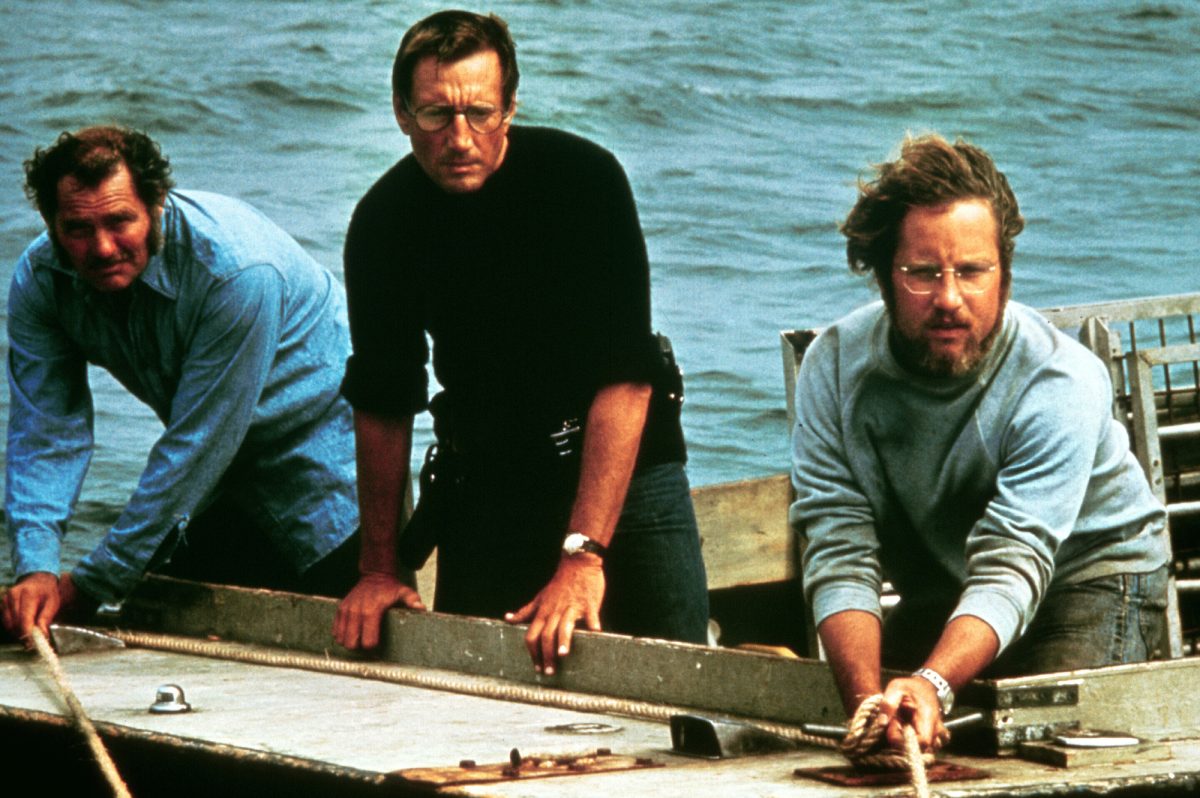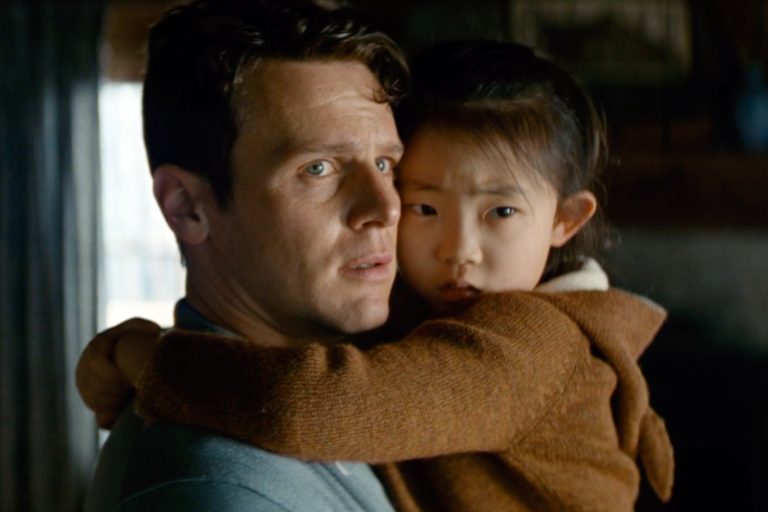It often happens that the fiercest creative impulse is born from a sudden, consuming interest in a new area of exploration. This isn’t unique to any one art form—each discipline is inspired in its own right. But the urge to etch that discovery into your own visual language, to fold it into the architecture of your artistic self, is a pleasure that often defies articulation. That same impulse must’ve surged through 29-year-old Steven Spielberg when “Jaws” (1975)—based on Peter Benchley’s 1974 novel, itself influenced by the exploits of Frank Mundus—hit screens and stamped its legacy.
A compelling, character-study-style dramatic thriller that elevates a grisly B-movie premise into a terrifying and oddly life-affirming meditation on shark attacks—and civil society’s systemic response to them—”Jaws” is remembered as the summer blockbuster that rewrote the very grammar of Hollywood’s campy seasonal spectacles. And how artfully it did so: the screenplay, co-written by Benchley and Carl Gottlieb, avoids strait-laced genre trappings and instead deconstructs escapism—while using escapists as its primary audience.
Turning a postcard paradise into a predator’s hunting ground is certainly a seductive idea for crafting both world and trauma. But to do so without commodifying panic, to approach that fear with a kind of moral clarity, is where “Jaws” truly earns its place.
So much has already been written to exalt “Jaws” that it almost demands a non-analysis. Still, here’s our attempt to explain the film, and a few of its select themes, to you.
Jaws (1975) Movie Plot Summary and Synopsis:
In the New England beach town of Amity Island, a young woman named Chrissy goes for a late-night swim in the ocean. An unseen force drags her under. Her partial remains are found washed ashore the next morning. After the coroner rules it a shark attack, Amity police chief Martin Brody closes the beaches. Mayor Larry Vaughn persuades him to reverse the decision, worried the town’s summer economy—especially during the approaching Fourth of July—will collapse. The coroner, seemingly pressured, now agrees with the mayor’s version that it was a boating accident.
Still, Martin remains watchful, quietly expecting another attack. Brody goes along with their explanation until young Alex Kintner is killed at a crowded beach—right in front of him, while his own son is swimming nearby.
Who offers to hunt the shark?
A $3,000 bounty placed by Mrs. Kintner triggers a chaotic wave of amateur shark hunters. One night, we see two men narrowly escape being pulled under by something massive. Quint, an eccentric local shark hunter, offers his services for $10,000. Oceanographer Matt Hooper examines Chrissy’s remains and confirms that an unusually large shark killed her.
What do Hooper and Brody discover on their boat trip?

Soon after, local fishermen catch a tiger shark. Vaughn declares the beaches safe. But when Mrs. Kintner arrives and learns the previous attack had already happened before her son was killed, she slaps Brody. Hooper, skeptical, dissects the tiger shark and finds no human remains inside its stomach. He’s convinced the killer shark is still out there.
That night, Hooper and Brody take his boat out and discover the wreck of Ben Gardner’s fishing vessel. Hooper dives to inspect the hull and finds a large shark tooth embedded in it—but drops it after stumbling upon Gardner’s severed head.
Why does Mayor Vaughn finally agree to hire Quint?
Despite Brody and Hooper’s insistence that a great white shark is responsible, Vaughn dismisses their warnings and keeps the beaches open, allowing only minor safety measures. On the Fourth of July weekend, tourists flood the town. After a brief scare caused by two kids faking a fin, the real shark enters a nearby lagoon, killing a man and nearly killing Brody’s son, Michael, who is hospitalized in shock. A shaken Vaughn finally agrees to hire Quint.
How large is the shark?
Tensions brew between Quint and Hooper, and Brody’s deep fear of the ocean hangs in the air. Still, the three set out to sea aboard Quint’s boat, the Orca, to hunt the shark. As Brody throws out chum, the shark suddenly surfaces behind the boat. Quint estimates it to be 25 feet long and 3 tons in weight. He harpoons it with a line tied to a flotation barrel, but the shark drags it underwater and vanishes.
Jaws (1975) Movie Ending Explained:
What story does Quint recount?
That night, Quint and Hooper drunkenly compare battle scars. Quint shows a spot where a tattoo once was, then recounts surviving the sinking of the USS Indianapolis in World War II, when sharks killed many of the stranded sailors. The three men laugh and drink until the shark returns, ramming the hull and cutting the power. They spend the night repairing the engine.
How is the shark killed?
In the morning, Brody tries to radio for help, but Quint, hell-bent on killing the shark alone, smashes the radio. After a long pursuit, Quint harpoons the shark with a second barrel. The line is tied to the boat’s stern cleats, but the shark pulls the Orca backward, flooding the deck and engine. As Quint tries to cut the line to save the transom, the cleats snap off. The barrels remain attached. Trying to lure the shark into shallower waters, Quint speeds toward shore. But the already-damaged engine gives out.
With the boat now taking on water, they try a last-ditch tactic. Hooper enters a shark-proof cage, intending to inject the shark with strychnine via a hypodermic spear. The shark attacks, Hooper drops the spear, and the cage is wrecked. Hooper escapes and hides on the seafloor. The shark crashes onto the boat’s stern, devouring Quint. Stranded on the sinking Orca, Brody shoves a scuba tank into the shark’s mouth. Climbing the crow’s nest, he fires at the tank with a rifle. The explosion kills the shark. Hooper resurfaces. He and Brody paddle back to shore, clinging to the floating barrels.
Jaws (1975) Movie Themes Analysed:
Fear, Capital, and American Denialism
The entire business model of Hollywood blockbusters hinges on using high-concept premises for relatively straightforward action-adventure films, a formula pioneered by “Jaws.” Pivoting from a social thriller to a survival-at-sea drama, the film refuses to treat the shark as a fully embodied creature that needs to be seen often or studied as closely by the audience as by Martin Brody. Spielberg uses the shark’s point of view as a tracking shot for its victims, avoiding its constant appearance even in moments when it is technically visible.
That’s because it operates less as a biological force and more as a structural one. It embodies the unchecked threats of a system that masks its rot with capital incentives and glorified illusions. In fact, the collective refusal to acknowledge this threat eerily mirrors post-World War II American optimism, to the point that the film needs an expository monologue reminding viewers how close the past actually still is.

In fact, the film adopts the tonal texture of a socially alert debut feature that breathes in real-world allegories. Nowhere is that more evident than in the character of the mayor—a bureaucrat who keeps compromising real danger to uphold a sellable illusion until it circles back to bite him. It’s not even a guarantee that the economic machine would’ve stopped churning if he and his own family weren’t physically present on the Fourth of July beach to witness the spiral. Even within a tightly contained studio framework, “Jaws” manages to etch a vivid picture of ecological blindness and disaster capitalism.
Masculinity at Sea
A relevant modern critique of “Jaws” is the sidelining and reduction of its female characters. The two women who register in memory are more archetypes than people: Christine Watson, whose death opens the film, and Ellen Brody, the classic supportive wife figure. While the absence of female agency may seem predictably dated through a feminist lens, it actually speaks volumes about the film’s time and temperament—an era when male camaraderie, survival, and conflict defined genre storytelling.
The absence of women becomes less an oversight and more a deliberate framing of masculine order, allowing “Jaws” to dissect it from the inside. The trio of Brody, Quint, and Hooper becomes a tense negotiation between the hunter, the scientist, and the law-bringer—three versions of masculinity trying to out-survive each other.
On one hand, the film appears to critique the very model it’s built on. Quint—the violent, self-mythologising war vet attempting to reclaim control over his past—gets devoured whole. It’s the pairing of Brody and Hooper, the rational and the emotionally aware, who survive. But how complete is that survival really? Spielberg doesn’t even let them reach shore—the film ends as they merely swim toward it. The implication is that in this negotiation between the old world and the new, it is the latter that must persist. Still, masculinity’s impulse remains dominion, destruction, and ego—and the film, campy as it is, doesn’t pretend otherwise. That’s what makes it smarter than it lets on.
Tourism and Safety: The Fragile Illusion of Public Trust
What “Jaws” understands better than most modern thrillers is that the real terror isn’t the shark—it’s the institutional insistence that nothing’s wrong. The film turns the American beach, a site of innocence, leisure, and postcard summer beauty, into a hostile ecosystem—a space where public safety is performative and people are collateral. It’s not just that the officials delay warning citizens; it’s that they actively suppress panic to preserve the illusion of control. The shark attacks are horrifying, yes—but it’s the meeting room scenes, the beach reopening, the kid’s blood cloud that are far more disturbing. They reveal a system calibrated to preserve capital flow, not civilian life.
The July Fourth weekend becomes the battleground of two opposing logics: public trust versus private motive. In its framing, the film edges uncomfortably close to real-life crisis management, where safety measures are often aesthetic—good optics, not good governance. Panic is worse than the truth because panic is bad for business. Even the framing of the “tourists” becomes symbolic—outsiders drawn into a space where the real threat is the local authority’s casual indifference. In many ways, “Jaws” was ahead of its time, recognizing how image management often replaces actual protection. That’s what keeps the tension simmering long before the shark returns.








![Bird Box [2018]: Netflix’s Most Popular Film Is Also The Most Problematic](https://79468c92.delivery.rocketcdn.me/wp-content/uploads/2019/01/bird-box-768x432.jpg)